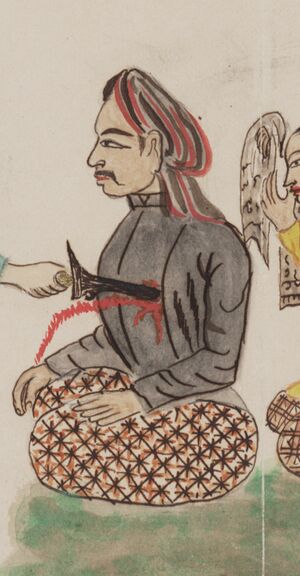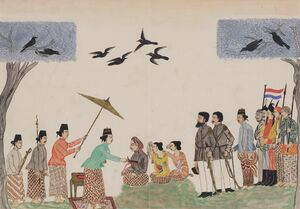تروناجايا
Trunajaya | |
|---|---|
 | |
| وُلِدَ | 1649 |
| توفي | 2 يناير 1680 Payak, East Java |
| أسماء أخرى | Panembahan Maduretna Panatagama |
| عـُرِف بـ | تمرد تروناجايا |
تروناجايا (Madurese) or Tronajâyâ, also known as Panembahan Maduretno (1649 – 2 يناير 1680[2]), was a prince and warlord from Arosbaya, Bangkalan، مادورا، عـُرف بقيادته تمرد تروناجايا (1674–1681) على حكام سلطنة مطرم في جزيرة جاوة.
التمرد
Trunajaya was born in Madura. In 1674 he led a revolt against Amangkurat I and Amangkurat II of Mataram.[3] He was supported by itinerant fighters from Makassar led by Karaeng Galesong.[3] انتشر تمرد تروناجايا بسرعة واكتسب زخماً، واستولى على بلاط مطرم at Plered in mid-1677.
The Mataram king, Amangkurat I, escaped to the north coast with his eldest son, the future king Amangkurat II, leaving his younger son Pangeran (Prince) Puger in Mataram. Apparently more interested in profit and revenge than in running a struggling empire, the rebel Trunajaya looted the court and withdrew to his stronghold in Kediri, East Java, leaving Prince Puger in control of a weak court.
While on his way to Batavia in order to ask the Dutch for help, Amangkurat I died in the village of Tegalarum near Tegal just after his expulsion, thus making Amangkurat II king in 1677.[3] He too was nearly helpless, having fled without an army or a treasury. In an attempt to regain his kingdom, he made substantial concessions to the Dutch East India Company (VOC) in Batavia, who then went to war to reinstate him. In agreement, he promised to hand over the port town of Semarang to the Dutch if they lent him troops.[3]
The Dutch agreed, since for them, a stable Mataram empire that was deeply indebted to them would help ensure continued trade on favourable terms. The multi-ethnic Dutch forces, consisting of light-armed troops from Makassar and Ambon, in addition to heavily equipped European soldiers, first defeated Trunajaya in Kediri in November 1678. Trunajaya himself was captured in 1679 near Ngantang west of Malang. He was executed by order of Amangkurat II in Payak, Bantul في 2 يناير 1680.
الذكرى
يـُذكر تمرد تروناجايا بفخر وإعزاز كنضال بطولي من شعب مادورا، ضد الاحتلالين الأجنبيين: سلطنة مطرم وشركة VOC الهولندية. Today his career is commemorated as the name of مطار ترونوجويو في سومنپ و جامعة ترونوجويو في Bangkalan، كلاهما في مادورا.
المراجع
- de Graaf, H. J. (1976) [1952]. "Capture and death of Raden Truna Jaya, December 1679 – January 1680". Islamic States in Java 1500–1700. By Pigeaud, Th.; de Graaf, H. J. The Hague: Martinus Nijhoff. pp. 82–84.
- Soekmono, R. (2003) [1973]. Pengantar Sejarah Kebudayaan Indonesia 3 (in Indonesian) (2nd ed.). Yogyakarta: Penerbit Kanisius. ISBN 979-413-291-8.
{{cite book}}: CS1 maint: unrecognized language (link)
الهامش
- ^ ""Vorst Mangkoe Rat II doorsteekt met zijn kris, genaamd "de eerwaarde Blabor", den opstandeling Troenadjaja, dien hij met zijne twee vrouwen Kliting Koening en Kliting Woengoe, zusters van den vorst voor zich had laten komen, niettegenstaande dien opst..." Leiden University Libraries Digital Collections.
- ^ de Graaf 1976, p. 81.
- ^ أ ب ت ث Soekmono 2003, p. 68.
